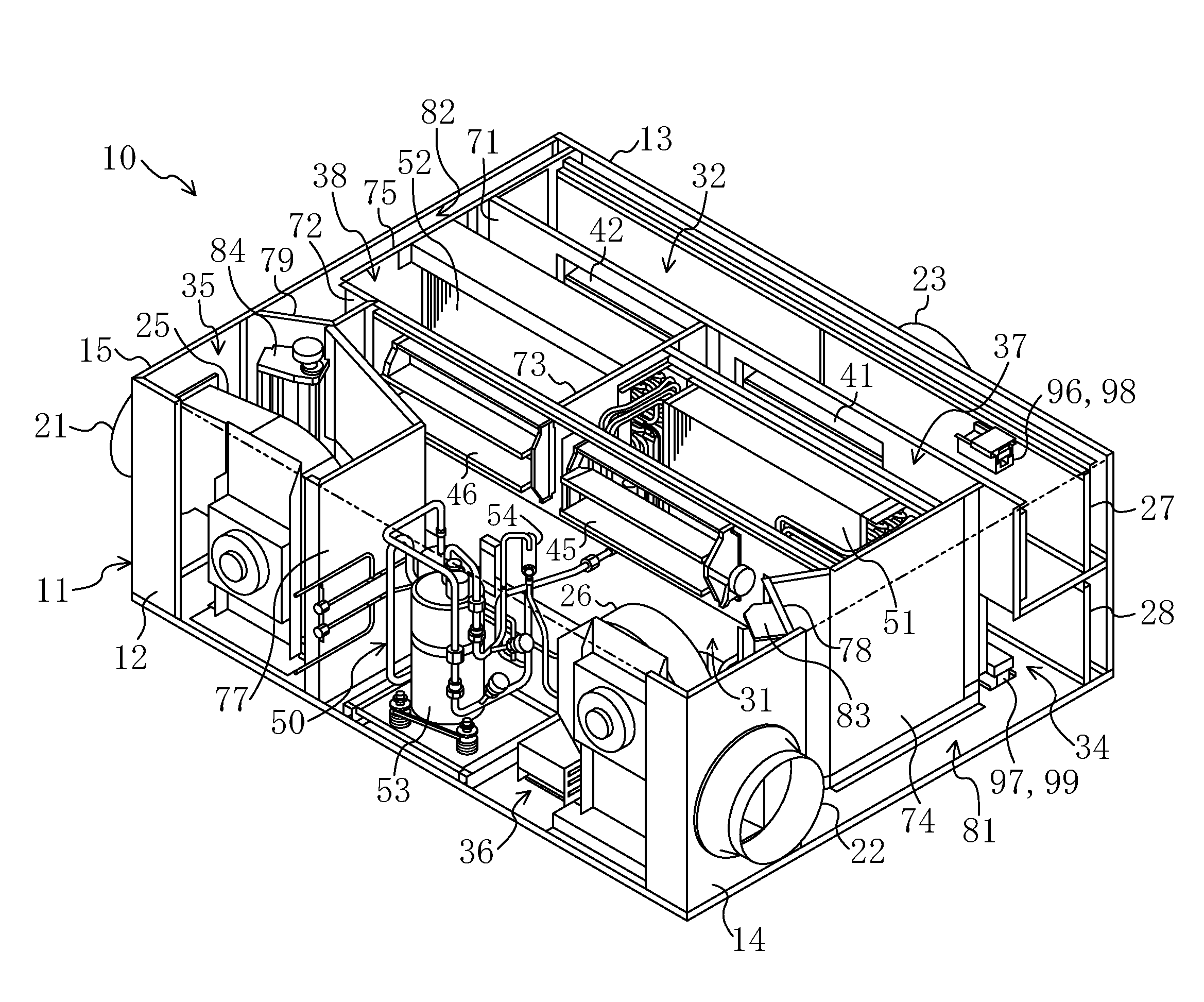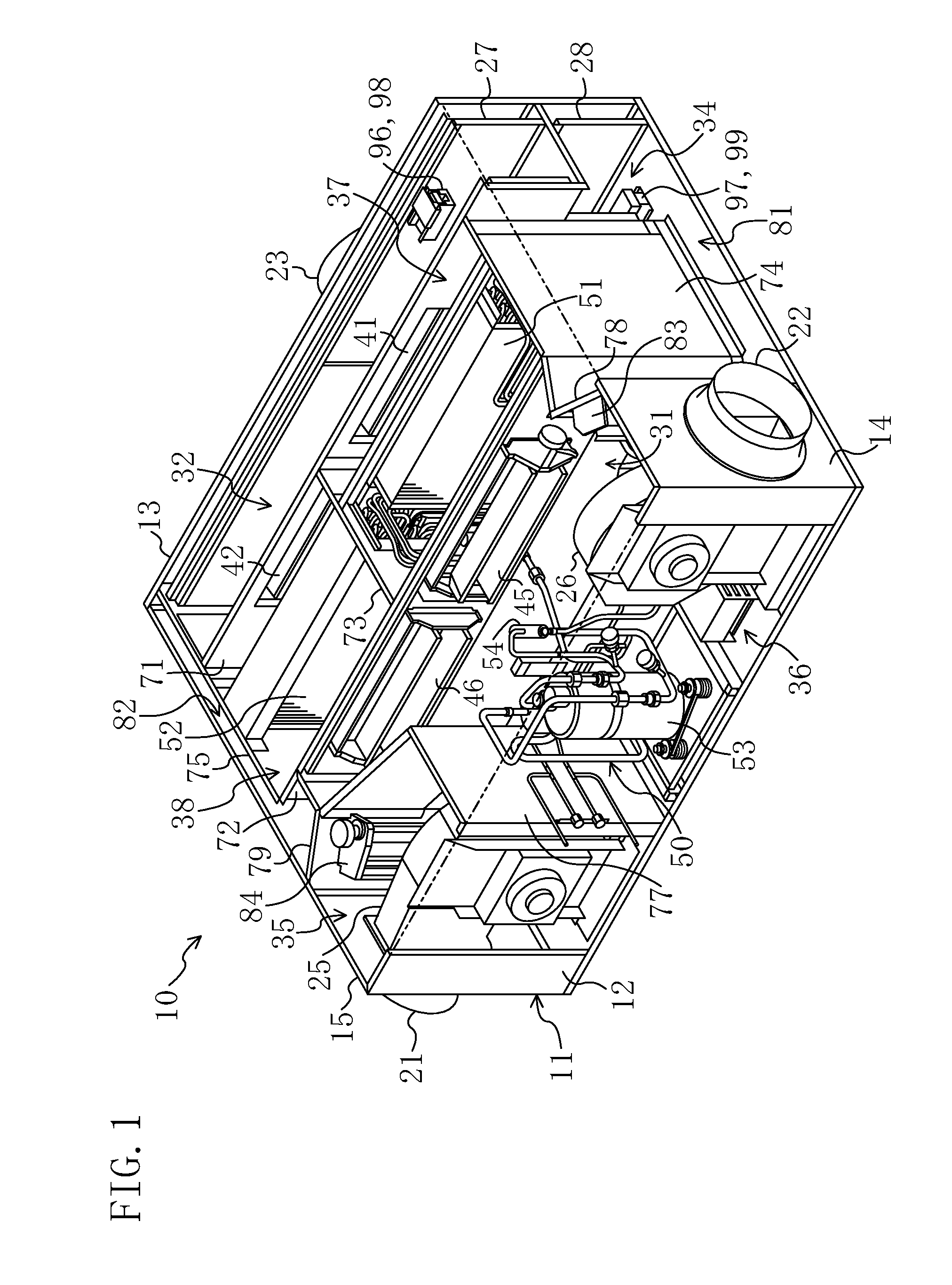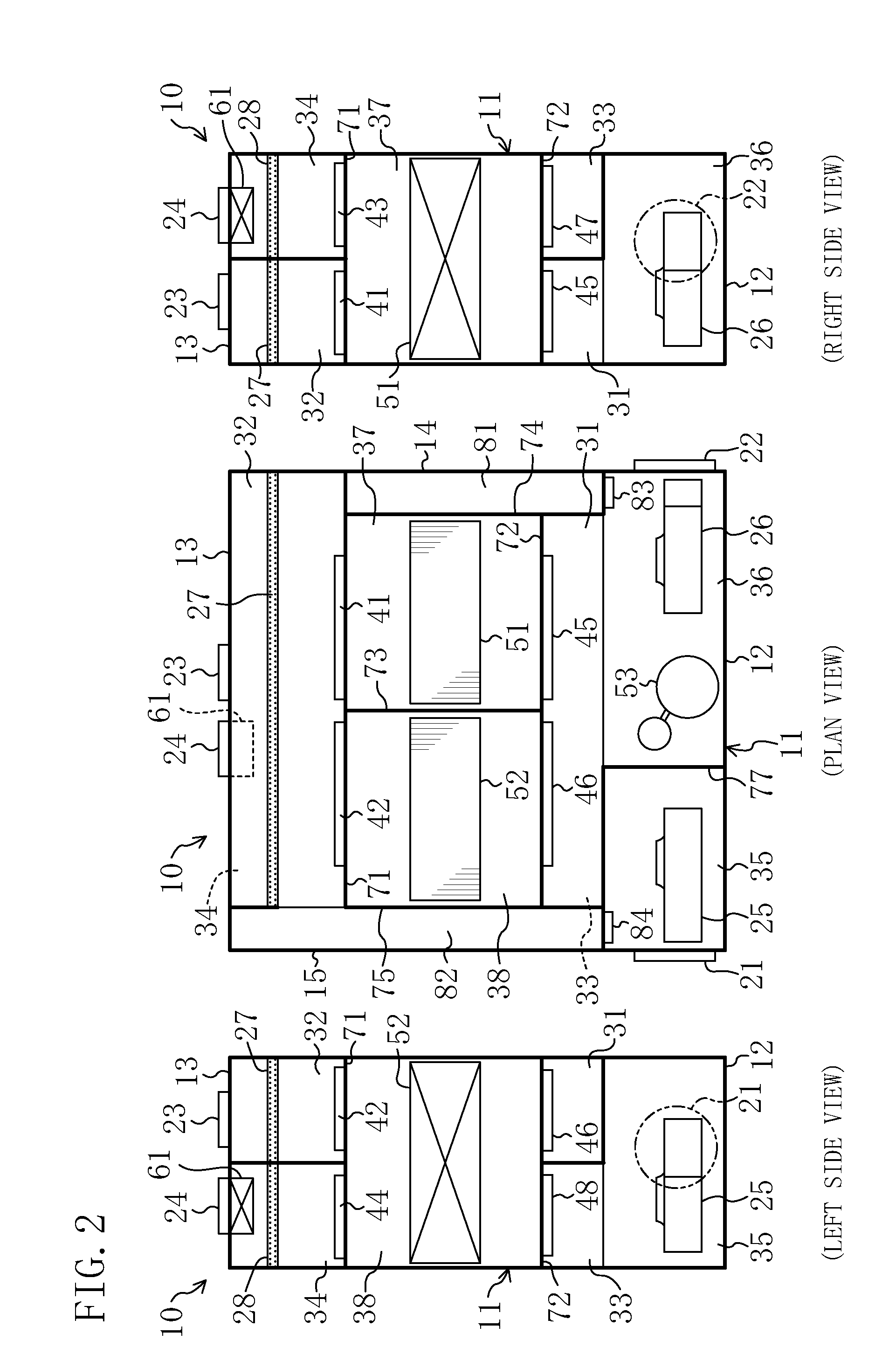[0048]In the second aspect of the invention, the refrigerant adjusting mechanism (62) switches the circulation of high-pressure refrigerant flowing through the main circuit (50a) to the circulation through the
auxiliary circuit (60). Thus, only when the preheating of recovery air to be supplied to the adsorption heat exchanger (51, 52) is required, the circulation of refrigerant flowing through the main circuit (50a) can be switched to the circulation through the
auxiliary circuit (60). That is, when the temperature of the recovery air to be supplied to the adsorption heat exchanger (51, 52) is the normal temperature (temperature from the ordinary temperature to the high temperature), refrigerant circulates through the main circuit (50a) without preheating the recovery air. On the other hand, when the temperature of the recovery air to be supplied to the adsorption heat exchanger (51, 52) is low, the refrigerant circulation is switched to the
auxiliary circuit (60), thereby heating the recovery air. This ensures the reduction or prevention of, e.g., the freezing of the air path through which the recovery air passes even when the temperature of the recovery air to be supplied to the adsorption heat exchanger (51, 52) is low; and ensures the reduction or prevention of the unnecessary heating in the auxiliary heat exchanger (61). Thus, the
energy conservation of the humidity control apparatus can be realized.
[0050]In the fourth aspect of the invention, the humidity control apparatus includes the
bridge circuit (110) in the
liquid line (50b) of the main circuit (50a), and the main expansion mechanism (55) is arranged in the one-way path (119) of the
bridge circuit (110). Further, the expansion bypass line (64) configured to bypass the main expansion mechanism (55) is provided. Thus, refrigerant passing through the main expansion mechanism (55) can constantly flow in one direction, and refrigerant passing through the expansion bypass line (64) can flow in one direction. That is, the flow of refrigerant passing through the expansion bypass line (64) is not reversibly switched, and therefore the auxiliary expansion mechanism (66) may be provided only on the downstream side of the auxiliary heat exchanger (61) in the refrigerant flow direction. This simplifies a configuration of the auxiliary circuit (60), thereby reducing a manufacturing cost of the humidity control apparatus.
[0051]In the fifth aspect of the invention, the auxiliary line (58) is provided, which connects the upstream side of the main expansion mechanism (55) of the one-way path (119) to the
liquid line (50b) between the
bridge circuit (110) and one of the adsorption heat exchangers (51, 52), and which has the capillary tube (59). Thus, liquid refrigerant accumulated between an inflow side of the main expansion mechanism (55) and an outflow side of the
check valve (115, 117) can be returned to the main circuit (50a) side. This ensure reduction or prevention of accumulation of a large amount of liquid refrigerant, i.e., liquid sealing on the inflow side of the main expansion mechanism (55).
[0052]In the sixth aspect of the invention, the bridge circuit (110) is provided in the expansion bypass line (64), and therefore refrigerant passing through the expansion bypass line (64) flows in one direction. Thus, refrigerant flowing into the auxiliary expansion mechanism (66) of the expansion bypass line (64) can flow in one direction. That is, the flow of refrigerant passing through the auxiliary expansion mechanism (66) is not reversibly switched, and therefore the auxiliary expansion mechanism (66) may be provided only on the downstream side of the auxiliary heat exchanger (61) in the refrigerant flow direction. This simplifies the auxiliary circuit (60), thereby reducing the manufacturing cost of the humidity control apparatus.
[0053]In the seventh aspect of the invention, the circulation of high-pressure refrigerant flowing through the high-pressure line (50c) is switched to the circulation through the auxiliary circuit (60). Thus, only when the preheating of recovery air to be supplied to the adsorption heat exchanger (51, 52) is required, the circulation of refrigerant flowing through the high-pressure line (50c) can be switched to the circulation through the auxiliary circuit (60). That is, when the temperature of the recovery air to be supplied to the adsorption heat exchanger (51, 52) is the normal temperature (temperature from the ordinary temperature to the high temperature), refrigerant circulates through the high-pressure line (50c) without preheating the recovery air. On the other hand, when the temperature of the recovery air to be supplied to the adsorption heat exchanger (51, 52) is low, the refrigerant circulation through the main circuit (50a) is switched to the circulation through the auxiliary circuit (60), thereby heating the recovery air. This ensures the reduction or prevention of, e.g., the freezing of the air path through which the recovery air passes even when the temperature of the recovery air to be supplied to the adsorption heat exchanger (51, 52) is low; and ensures the reduction or prevention of the unnecessary heating in the auxiliary heat exchanger (61). Thus, the
energy conservation of the humidity control apparatus can be realized.
[0054]According to the eighth aspect of the invention, the first auxiliary circuit (60a) and the second auxiliary circuit (60b) are connected to the
liquid line (50b) of the main circuit (50a). Thus, only when the preheating of recovery air to be supplied to the adsorption heat exchanger (51, 52) is required, the circulation of refrigerant flowing through the main circuit (50a) can be switched to the circulation through the auxiliary circuit (60), and the recovery air can be heated by refrigerant condensed in the adsorption heat exchanger (51, 52). That is, heat remaining in refrigerant after the recovery process (i.e., heat dissipation (or condensation)) in the adsorption heat exchanger (51, 52) can be used to heat the recovery air. This allows an effective use of heat from refrigerant flowing through the refrigerant circuit (50), thereby realizing the
energy conservation of the humidity control apparatus.
[0055]According to the ninth aspect of the invention, the bridge circuit (110) is provided in the liquid line (50b) of the main circuit (50a). The flow of refrigerant flowing into the main expansion mechanism (55) flows in one direction, and the circulation of refrigerant flowing through the one-way path (119) of the bridge circuit (110) is switched to the circulation through the auxiliary circuit (60). Thus, refrigerant passing through the auxiliary circuit (60) can flow in one direction. That is, the flow of refrigerant passing through the auxiliary circuit (60) is not reversibly switched, and therefore the auxiliary heat exchanger (61) may be provided only on the upstream side of the main expansion mechanism (55) in the refrigerant flow direction. This simplifies the configuration of the auxiliary circuit (60), thereby reducing the manufacturing cost of the humidity control apparatus.
[0056]According to the tenth aspect of the invention, the
noise canceling unit (65) is provided on the upstream side of the auxiliary heat exchanger (61) in the refrigerant flow, and therefore
noise caused due to air vibration in the bridge circuit (110) can be cancelled.
[0057]According to the eleventh aspect of the invention, the first expansion mechanism (55a), the auxiliary heat exchanger (61), and the second expansion mechanism (55b) are connected together in series. Thus, even if refrigerant circulating through the refrigerant circuit (50) flows in any of forward and backward directions, high-pressure refrigerant can flows into the auxiliary heat exchanger (61), and an amount of refrigerant flowing into the auxiliary heat exchanger (61) can be adjusted.
[0058]In the twelfth aspect of the invention, the heat exchange bypass line (67) is provided, which connects the upstream side of the auxiliary heat exchanger (61) of the one-way path (119) of the bridge circuit (110) to the
discharge side of the compressor (53), and the refrigerant circulation through the refrigerant circuit (50) is switched between the circulation through the main circuit (50a) and the circulation through the heat exchange bypass line (67). Thus, the circulation in the refrigerant circuit (50) can be switched to the circulation through the heat exchange bypass line (67). That is, high-pressure refrigerant discharged from the compressor (53) flows into the auxiliary heat exchanger (61) without dissipating heat in the adsorption heat exchanger (51, 52). This improves heating performance of recovery air to be supplied to the adsorption heat exchanger (51, 52).
 Login to View More
Login to View More  Login to View More
Login to View More 


